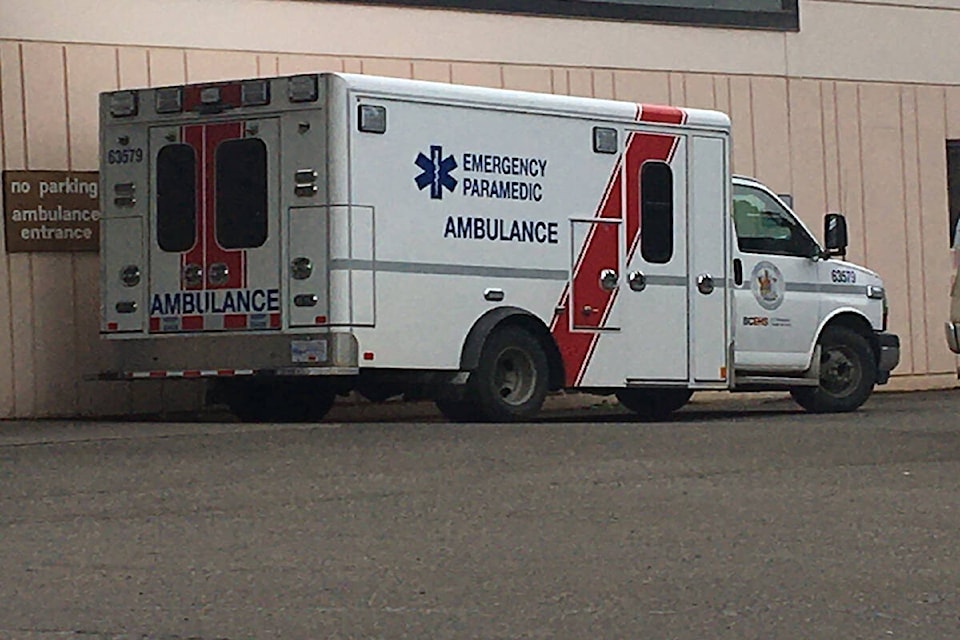Ambulance wait times in Smithers and area have increased significantly in recent years, according to BC Emergency Health Services (BCEHS). Contributing factors include a surge in call volumes from COVID-19, overdose-related calls, extreme weather events and a growing and aging population with complex health needs. As COVID-19 restrictions were lifted, traffic and recreational incidents also increased, further straining the emergency services system.
BCEHS reported an almost 23 per cent increase in high-priority purple and red-coded calls, which include overdoses and heart attacks, in Smithers for 2022/2023 compared to 2018/2019.
Meanwhile, average ambulance response times have steadily increased from six minutes and 35 seconds in 2018/2019 to eight minutes and 24 seconds in 2022/2023. The provincial target for those types of calls is nine minutes.
For orange-coded calls, which encompass stroke-like symptoms, the average wait time has increased from seven minutes and 40 seconds in 2018/2019 to nine minutes and 45 seconds in 2022/2023. And for the lowest acuity calls, which are yellow-coded and include concerns such as a sprained ankle, wait times have increased more dramatically — from nine minutes and one second in 2018/2019 to 12 minutes and 59 seconds in 2022/2023.
Can’t see the above table? Click here.
Troy Clifford, who is president of the BC Ambulance Paramedics union, attributed the increased wait times to a lack of resources and insufficient staffing.
Ambulances are often idle due to staff shortages, and hospital transfers have slowed response times, he said. And although most paramedics are now full-time, many positions remain unfilled.
Paramedics have also reported a significant increase in mental health and addiction-related calls, with eight people now dying daily from opioid overdoses in the province. The lack of doctors and community care resources has placed additional strain on emergency services and many communities are now relying on paramedics as a primary point of care.
Clifford says the increased calls for mental health and addictions is in every corner of the province.
“It’s not just a big city thing,” he said.
Clifford suggests that an expanded community ambulance program, providing additional support for mental health, addictions, and homeless populations, as well as better serving Indigenous communities, could help address the issue. Additionally, retaining local and community members in emergency service roles could improve resource availability.
The community ambulance program has paramedics visiting people in their homes to provide primary care and helping avoid emergency medical situations. Provincewide, almost 900,000 people don’t have access to a family doctor, the latest provincial statistics indicate.
READ MORE: Granisle ambulance service beefed up
The provincial government has made efforts to increase the number of paramedics by paying for initial paramedic training, which is now less centralized and delivered through the Justice Institute.
The recent collective bargaining agreement between BCEHS and the union is expected to help with staff burnout and retention by increasing full-time employment for paramedics and emergency responders. However, the challenge remains to staff secondary ambulances, as they are paid on a part-time basis with low hourly, on-call rates.
Clifford says 50 per cent of community paramedic programs remain vacant.
“We’re on the right path, but there’s a lot of work left to do,” he said.
Smithers Fire Chief Kelly Zacharias said their department are trained with basic first aid and can help out until an ambulance arrives. He said longer wait times are always a concern for everyone involved.
“We do get calls for delayed responses from ambulances,” he said. “We work closely with them. Our call volume does go up when that happens but I know they are working hard to get more manpower, more full-time staff to alleviate the problem. It isn’t overwhelming for us, it just makes us a bit busier.”
-with files from Marisca Bakker
